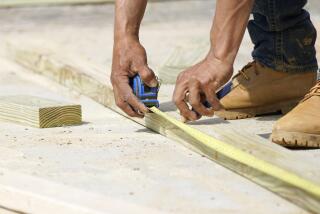Strategize Before Tackling the Job
- Share via
All thumbs? You have plenty of company.
One of the most frustrating aspects of homeownership, most owners report, is the seemingly endless stream of fix-it problems large and small that seem to keep popping up in any house: everyday annoyances like a shower that won’t drain, a toilet that runs on or a door that suddenly sticks.
Or maybe you’re rattled because the new computer workstation or modular storage cabinet you just bought has a small mountain of parts that needs to be put together.
For some fortunate souls who are simply born handy, these are minor jobs. For most people, however, these household crises become a significant source of aggravation.
The answer, though, may lie in gaining a sense of courage to attempt those do-it-yourself projects that seem insurmountable. The first step is to acquire a strategy for successful home improvement work.
Here are the basic elements of a workable home improvement strategy:
1) Use your resources. Ask how-to questions of salespeople in hardware stores and supply houses. Many of them are former tradespeople themselves and can be very helpful about how to do it and what tools are needed.
Barring this, try calling that annoying friend or relative who is always bragging about some new project he’s working on.
Also, visit the home improvement section of your library or local bookstores. You will find many well-written and well-illustrated how-to manuals.
2) Plan ahead. Imagine yourself doing the job according to the instructions you have been given or read about. Carefully contemplate each step of the procedure. Think about the processes and what tools you may need.
Try to anticipate problems you may encounter and how you can either avoid them or solve them if they arise.
3) Use common sense and take precautions. Never work on live circuits and never presume that a circuit is off when the breaker is flipped, always check the wires with a tester before starting work.
Keep a fire extinguisher handy if you are working with flammable materials or with heat-producing tools.
Wear goggles when working with impact or cutting tools of any kind.
Wear hearing protectors when hammering or using power tools. Add a dust mask when sanding or power sawing.
If you’re working on a ladder, have a helper hold the ladder base for you, and never go higher than the highest safe rung indicated by the manufacturer.
Before you open any water valve, make sure the water is off and the pressure released by turning on a faucet.
4) Make sure your resources are available. Do not start a job unless you can reach people for advice along the way or you are sure that stores are open for replacement parts.
For example, never begin a plumbing project near the end of day, at night or on a holiday. If you do, you have a 100% chance of some valve or fitting breaking, leaving you with no water until the stores open the next morning.
5) Read instructions very carefully. Take the time to read through the instructions so you have a sense of where you are going before you start. And look at the parts list so you can identify what you find in the box while making sure that everything is there.
Look at the diagrams carefully, too. They often tell as much and sometimes more than the written text, so focus on them with great scrutiny.
Also, be wary of incorrect instructions. If you do everything they tell you to do and it still does not look right or work properly, it might not be your fault. Product instructions are often poorly written and can be misleading. Experiment with putting it together differently, or call the store to describe the problem.
6) Pay close attention to how the failed or broken assembly or part looks before you take it apart. It is funny how short-term memory fails as soon as all the parts are in a pile on the floor. Make a diagram or take a photo if necessary.
If you are working with wires, label each one with tape to indicate where it was connected before you pulled it out. Put all the fasteners in a safe place; you may want to label them.
7) Don’t rush it. Here is where the adage “There is never enough time to do it right, but always enough time to do it over” really applies.
Don’t expect to be able to do it with the speed of a professional who does this work every day. Take your time to make sure that every step is correct before continuing to the next. You really feel stupid when you have to undo the last five steps of a project to correct something you rushed through.
8) Keep it fun. Try not to get too frustrated if it does not work right the first time. Any new task will have its learning curve, and next time it will be much easier.
Just keep in mind that the harder it seems to be to do, the greater the sense of accomplishment you will feel.
More to Read
Inside the business of entertainment
The Wide Shot brings you news, analysis and insights on everything from streaming wars to production — and what it all means for the future.
You may occasionally receive promotional content from the Los Angeles Times.










